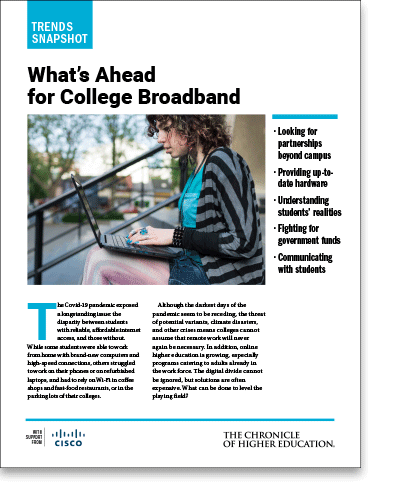

.

The pandemic exposed the digital divide between students with access to reliable internet access and technology and those without. Although many students have returned to campus, online learning continues to grow, particularly to meet the needs of adult and non-traditional learners. What are colleges doing to help level the playing field — even if higher ed can’t solve the issue all on its own?
What’s Ahead for College Broadband examines the trends colleges need to understand in order to take further steps in making education available for all, including:
- Looking for partnerships beyond campus Colleges can model the approach taken by many K-12 institutions by looking to outside organizations to help equip their students with the technology they need.
- Providing up to date hardware For students with slow, outdated technologies, a strong internet connection still doesn’t solve the problem of accessing online materials.
- Understanding students’ realities Colleges must recognize that technology can be both an opportunity and a peril for certain student populations.
- Fighting for government funds Infrastructure money earmarked for broadband updates can help close the divide and address some of the needs of low income students, but some gaps may remain.
- Communicating with students Colleges should understand the importance of letting students know what’s available to them and how they can voice their needs to their institutions.
.
The pandemic exposed the digital divide between students with access to reliable internet access and technology, and those without. Although many students have returned to campus, online learning continues to grow, particularly to meet the needs of adult and non-traditional learners. What are colleges doing to help level the playing field — even if higher ed can’t solve the issue all on its own?
What’s Ahead for College Broadband examines the trends colleges need to understand in order to take further steps in making education available for all, including:
- Looking for partnerships beyond campus Colleges can model the approach taken by many K-12 institutions by looking to outside organizations.
- Providing up-to-date hardware For students with slow, outdated technologies, a strong internet connection still doesn’t solve the problem of accessing online materials.
- Understanding students’ realities Colleges must recognize that technology can be both an opportunity and a peril for certain student populations.
- Fighting for government funds Infrastructure money earmarked for broadband updates can help close the divide.
- Communicating with students Colleges should understand the importance of letting students know what’s available to them.
.
.

